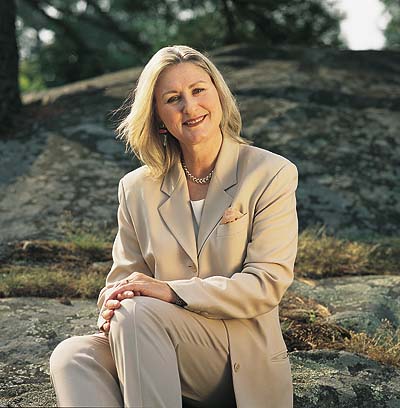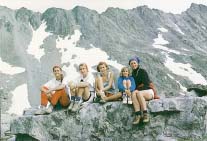 |
 |
| current issue |  |
past issues |  |
send a letter/news |  |
address update |  |
advertise |  |
about us |  |
alumni home |
Features
The Route to the TopA new president maps the university's next ascent
by Maggie Paine
On a wall in the parlor of the president's house at the University of New Hampshire is a photograph of an alpine lake surrounded by jagged peaks thrusting 12,000 feet into the Wyoming sky. This is Long Lake in the Wind River Range, where UNH's new president, Ann Weaver Hart, and her husband, Randy, camped one night during a 12-day hike into the outback in 1980.
 |
The Wind River Range lies along the Continental Divide. It is a wild and beautiful place, where peaks of fractured granite drop sharply into canyons and trout streams meander through alpine meadows. In places, the ruts left by the wagons of pioneers on the Oregon Trail and an occasional cairn are the only reminders that others might have passed this way before.
The Harts have spent years exploring this remote land, first by themselves, then with their four daughters, most recently with their prospective sons-in-law in tow. On the occasion recorded by Randy's camera lens, the couple were navigating using a U.S. Geological Survey map to identify topographical features like ridges and major outcroppings and following game trails as they switchbacked up the ridge.
When the summer sun dropped below a cloudbank on the horizon, their goal, Europe Canyon, was nowhere in sight. They made camp on a steep slope at 11,000 feet, far above the timberline. The temperature plummeted; the wind tugged at the sides of the tent and whined around the guy ropes. Thunder crackled and lightning jumped from cloud to peak. Lying in the tent as the rain drenched the land and lightning flashes glared through the fabric of the tent, the Harts wondered where they had ended up.
 Ann Weaver Hart with her daughters, Kimberly, Emily, Liza, and Allyson, in Wyoming, 1988 |
The next day, the sun returned, shimmering on ice floes in the lake below, and the Harts climbed over a nearby ridge and found their way into Europe Canyon. It wasn't until years later that they pinpointed exactly where they had been.
"Although they can help us find our way, maps cannot walk us to our destination," Ann Hart writes in her book The Principalship: a Theory of Professional Learning and Practice. Every cross-country hiker quickly learns that unanticipated obstacles inevitably create detours from the course laid out on a map, and often it is decisions made on the spot that determine where the traveler winds up. "To the pilgrim passing through the mountains, experience is the richest and most memorable source of knowledge. A journey on foot has no parallel and remains forever vivid and personal for those who take it. Each pass, each river teaches something new. Each thunderstorm remains forever in the memory."
UNH's 18th president sees her new job as that kind of journey. She knows where she wants to lead the university, has a good plan for getting there and is quite prepared to adjust her course when circumstances require her to do so. That's the approach she took at Claremont Graduate University, where she was provost and vice president for academic affairs from 1998 until this summer, and at the University of Utah, where she was dean of the Graduate School and then special assistant to the president from 1993 to 1998.
Hart has given a lot of thought to leadership and the qualities and circumstances that make a new leader successful. She has written a slew of books and articles on leadership and succession in schools and has served as a consultant on educational leadership to school districts, institutes and universities around the country and the world.
"When a person holding an influential office in a formal organization (such as a manager or chief executive) is replaced, the effects reverberate throughout the organization," she wrote in Principal Succession: Establishing Leadership in Schools. "The magnitude of this experience and its impacts on relationships, expectations and outcomes may vary, but all feel its effects. Succession brings the issue of leadership close to the surface of organizational consciousness at all levels. Those who appoint new leaders, those who work with them and those whose lives may be affected by them watch for signs that the change will make a positive difference in their work lives and outcomes. The effects are felt by the new manager as well. Before and after succession, newly appointed administrators strive for success under the pressure of personal and professional transition."
So how will Hart and UNH weather the transition that's going on right now? Very well, predicts John Crosier, who chaired the search committee that recommended her for the UNH presidency. "We were looking for someone with a proven track record of being able to deal with difficult issues," he says. "If you talk to her colleagues, she has taken on very complex and contentious issues within an academic setting. Running a university is quite different from running a company. You have to have a great capacity for persuasion, and you have to be able to listen and synthesize various viewpoints that are often conflicting and then construct and implement the strategies to get the job done."
Hart's former colleagues are quick to agree that she is a remarkably effective leader. Steadman Upham, president of Claremont Graduate University, describes her as "one of the rising stars of academic leadership in the country." Other administrators there say she did more for the university in four years than most people could accomplish in twice that time.
Page: 1 2 3 4 Next >Easy to print version
blog comments powered by Disqus
